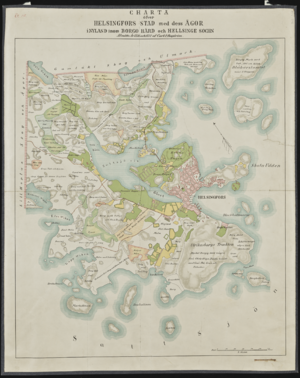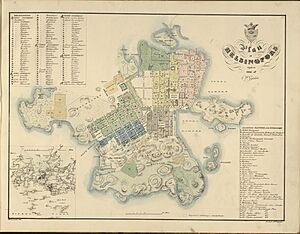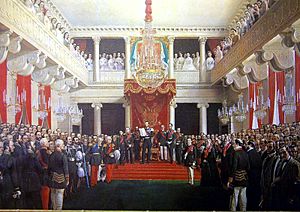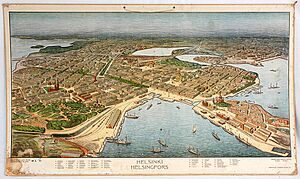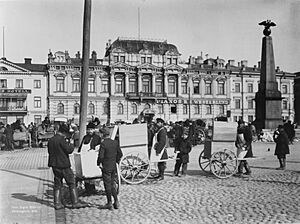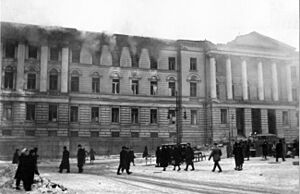History of Helsinki facts for kids
Helsinki is the capital city of Finland and its biggest city. It was started a long time ago in the Middle Ages. The idea was for it to be a Swedish port city, like a rival to other important ports on the Gulf of Finland. But for over 200 years, it stayed a small fishing village.
Its importance grew in the mid-1700s when a big fortress called Sveaborg was built. This fortress was on islands at the entrance to the harbor. It was meant to protect Helsinki from Russia. However, during the Finnish War (1808-1809), Sveaborg surrendered to Russia. Finland then became part of the Russian Empire.
After this, Russia moved Finland's capital from Turku to Helsinki in 1812. Helsinki then grew a lot during the 1800s. In the early 1900s, Finland became independent. There was also a civil war and three wars linked to World War II. These events made Helsinki a very active place politically and militarily.
Helsinki hosted the Summer Olympic Games in 1952. It was also a European Capital of Culture in 2000 and the World Design Capital in 2012. Experts consider it an important global city.
Contents
Helsinki's Early Days Under Sweden
Helsinki was founded by Swedish King Gustav I in 1550. Back then, it was called Helsingfors. King Gustav wanted the town to help gather trade in southern Finland. He also wanted it to compete with Reval (now Tallinn), a nearby city that controlled most of the trade.
To make the city successful, the king ordered people from other towns to move to Helsingfors. But this didn't work as planned. In 1561, Sweden took control of northeastern Estonia, including Reval. This made the Swedish king less interested in making Helsingfors a rival. So, Helsingfors remained a quiet village for many years.
In 1640, Helsingfors was moved south to a better harbor near the mouth of the Vantaa River. But even this didn't attract many traders. In 1710, a terrible plague killed most of the people living in Helsingfors.
Later, as Russia became stronger in the Baltic Sea, Sweden decided to protect Helsingfors. They started building the island fortress of Sveaborg in 1748. This was to defend the city from Russian attacks.
During the Finnish War, Russian forces captured Helsingfors in March 1808. They then surrounded the Sveaborg fortress until it surrendered in May. Also, about a quarter of the town was destroyed by a fire in November of that year.
Helsinki as Finland's Capital
After Russia won the Finnish War, Finland became part of Russia in 1809. In 1812, the Russian Tsar moved the capital of Finland from Turku to Helsinki. Turku was closer to Sweden, and the Tsar believed Helsinki would be easier to control. Helsinki was also closer to St. Petersburg, Russia's capital, and the Sveaborg fortress offered good sea protection.
Once Helsinki became the capital, the Russian Tsar ordered the city to be rebuilt. He wanted it to look like a stylish, modern capital, similar to St. Petersburg. The new plan was started in 1816 by architect Carl Ludvig Engel. His plan focused on a large city square, now known as Helsinki Senate Square.
Early buildings included the Government Palace (1822) and the Helsinki Old Church (1826). After a big fire in Turku in 1827, Finland's only university was also moved to Helsinki. It was renamed the Imperial Alexander University and is now the University of Helsinki. Engel designed the main university building (1832) and the university library (1844), which is now the National Library of Finland. Moving the university helped Helsinki become even more important and grow steadily.
The plan to make Helsinki a grand capital was completed with the Helsinki Cathedral in 1852. This beautiful cathedral was meant to be the main building of Senate Square. Its construction took from 1830 to 1852. The cathedral, originally called St. Nicholas Church, is now a famous symbol of Helsinki. You can easily see it when arriving by boat.
During the 1800s, Helsinki became the most important place for business and culture in Finland. New technologies like railroads and factories helped the city grow a lot. The first railway station opened in 1862, connecting Helsinki to Hämeenlinna.
By the late 1800s, more and more people moving to Helsinki spoke Finnish. This made Finnish the main language in the city, though many people still spoke Swedish. Today, Swedish speakers are a small group.
Helsinki's role as the capital meant many big events in Finnish history happened there. For about 90 years, Russian rule helped Helsinki and Finland develop. But in 1899, Russia started trying to make Finland more Russian. This was called the Russification of Finland. In 1898, a military officer named Nikolay Bobrikov was sent to Finland to speed up this process. He was very unpopular, and in 1904, he was assassinated in Helsinki's Government Palace.
Helsinki in the 20th Century and Today
People in Finland were unhappy with Russian rule and wanted independence. In 1917, Finland became fully independent during the Russian Revolution. But right after gaining independence, Finland had a 3.5-month civil war. One side, the socialists/communists (called Reds), fought against the conservative government (called Whites).
The fighting began on January 26, 1918, when a red lantern was lit in the tower of the Helsinki Workers' Hall. Since Helsinki was in Red territory, the Finnish government left the city and moved to Vaasa. The Red government was set up in Helsinki. German soldiers, who were allies of the White Guard, took Helsinki back from the Reds on April 13, 1918. Many Red prisoners died after the war while being held by the Whites, including at the Suomenlinna fortress.
Finland became a democratic country between the two World Wars. In 1939, the Soviet Union attacked Finland, starting the Winter War. Helsinki was bombed several times during this war. After a difficult peace agreement, Finland joined Nazi Germany as a "co-belligerent" in World War II. They fought another war against the Soviet Union, called the Continuation War. This led to more bombings of Helsinki from 1941 to 1944, with the biggest attacks in February 1944.
After the war, Finland had to pay money to the Soviet Union. But despite this, Helsinki and Finland grew and became successful. A big event was hosting the 1952 Summer Olympics. In the 1970s, many people moved from the countryside to cities, and Helsinki's population tripled. The Helsinki Metro subway system was built.
Helsinki was a European Capital of Culture in 2000 and the World Design Capital in 2012. It is still considered an important global city today.
Helsinki's Population Growth
Helsinki's population grew quickly after it became the capital in 1812. Here's how it changed over time:
- 1810: 4,070 people
- 1830: 11,100 people
- 1850: 20,700 people
- 1880: 43,300 people
- 1900: 93,600 people
- 1925: 209,800 people
- 1960: 425,000 people
- 2001: 559,718 people
- 2012: 596,233 people
- 2017: 635,000 people
See also
 In Spanish: Historia de Helsinki para niños
In Spanish: Historia de Helsinki para niños
- Timeline of Helsinki
- History of Finland
- History of Turku
- Helsinki City Museum


